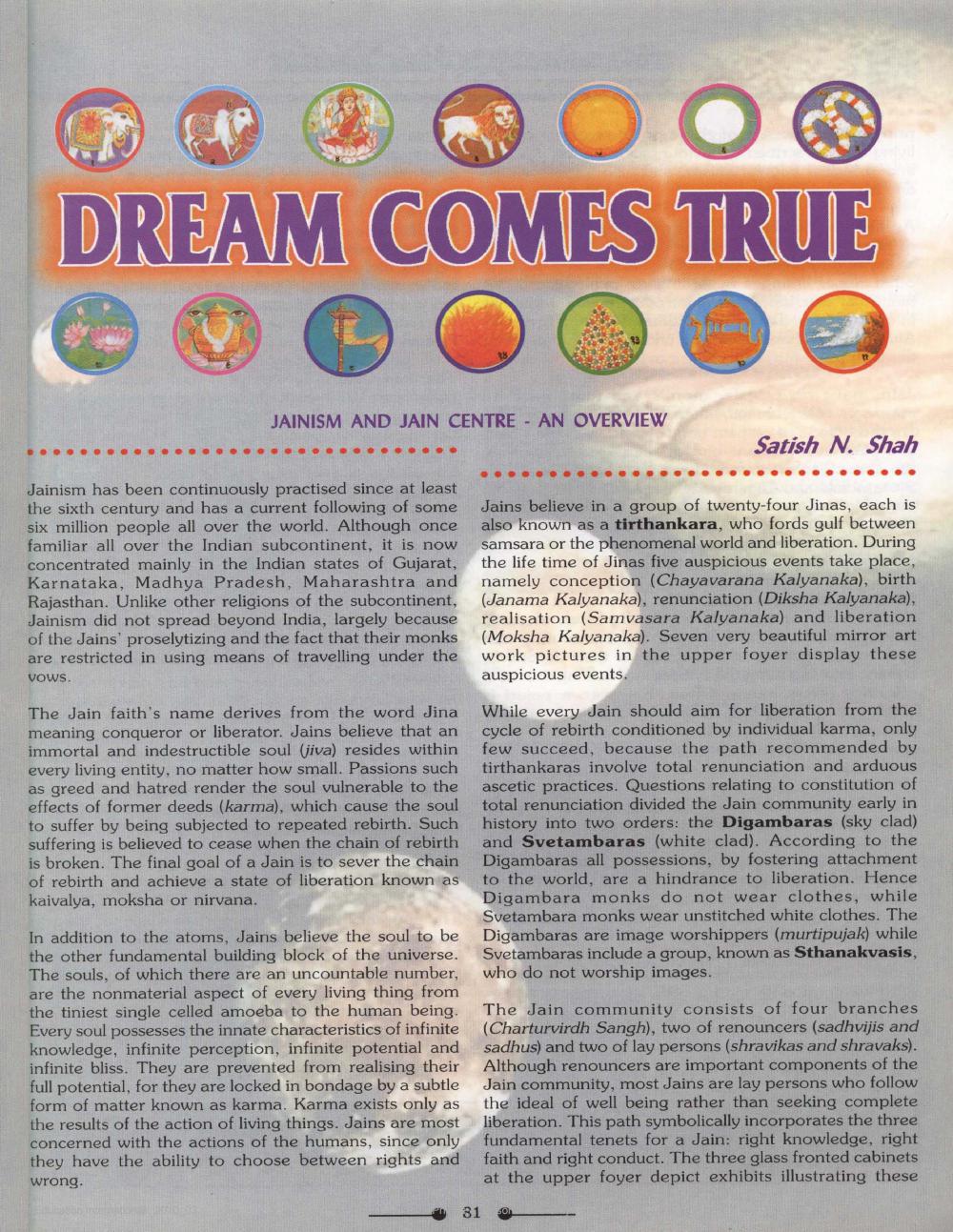________________
DREAM COMES TRUE
JAINISM AND JAIN CENTRE - AN OVERVIEW
Satish N. Shah
Jainism has been continuously practised since at least the sixth century and has a current following of some six million people all over the world. Although once familiar all over the Indian subcontinent, it is now concentrated mainly in the Indian states of Gujarat, Karnataka, Madhya Pradesh, Maharashtra and Rajasthan. Unlike other religions of the subcontinent, Jainism did not spread beyond India, largely because of the Jains proselytizing and the fact that their monks are restricted in using means of travelling under the VOWS.
Jains believe in a group of twenty-four Jinas, each is also known as a tirthankara, who fords gulf between samsara or the phenomenal world and liberation. During the life time of Jinas five auspicious events take place, namely conception (Chayavarana Kalyanaka), birth (Janama Kalyanaka), renunciation (Diksha Kalyanaka), realisation (Samvasara Kalyanaka) and liberation (Moksha Kalyanaka). Seven very beautiful mirror art work pictures in the upper foyer display these auspicious events.
The Jain faith's name derives from the word Jina meaning conqueror or liberator. Jains believe that an immortal and indestructible soul (jiva) resides within every living entity, no matter how small. Passions such as greed and hatred render the soul vulnerable to the effects of former deeds (karma), which cause the soul to suffer by being subjected to repeated rebirth. Such suffering is believed to cease when the chain of rebirth is broken. The final goal of a Jain is to sever the chain of rebirth and achieve a state of liberation known as kaivalya, moksha or nirvana.
While every Jain should aim for liberation from the cycle of rebirth conditioned by individual karma, only few succeed, because the path recommended by tirthankaras involve total renunciation and arduous ascetic practices. Questions relating to constitution of total renunciation divided the Jain community early in history into two orders: the Digambaras (sky clad) and Svetambaras (white clad). According to the Digambaras all possessions, by fostering attachment to the world, are a hindrance to liberation. Hence Digambara monks do not wear clothes, while Svetambara monks wear unstitched white clothes. The Digambaras are image worshippers (murtipujak) while Svetambaras include a group, known as Sthanakvasis, who do not worship images.
In addition to the atoms, Jains believe the soul to be the other fundamental building block of the universe. The souls, of which there are an uncountable number, are the nonmaterial aspect of every living thing from the tiniest single celled amoeba to the human being. Every soul possesses the innate characteristics of infinite knowledge, infinite perception, infinite potential and infinite bliss. They are prevented from realising their full potential, for they are locked in bondage by a subtle form of matter known as karma. Karma exists only as the results of the action of living things. Jains are most concerned with the actions of the humans, since only they have the ability to choose between rights and wrong.
The Jain community consists of four branches (Charturvirdh Sangh), two of renouncers (sadhvijis and sadhus) and two of lay persons (shravikas and shravaks). Although renouncers are important components of the Jain community, most Jains are lay persons who follow the ideal of well being rather than seeking complete liberation. This path symbolically incorporates the three fundamental tenets for a Jain: right knowledge, right faith and right conduct. The three glass fronted cabinets at the upper foyer depict exhibits illustrating these
31 cod




